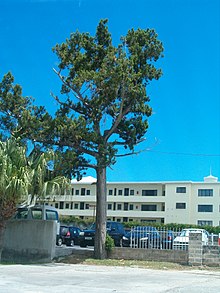| Bermuda cedar | |
|---|---|

| |
| Scientific classification | |
| Kingdom: | Plantae |
| Clade: | Tracheophytes |
| Clade: | Gymnospermae |
| Division: | Pinophyta |
| Class: | Pinopsida |
| Order: | Cupressales |
| Family: | Cupressaceae |
| Genus: | Juniperus |
| Species: | J. bermudiana
|
| Binomial name | |
| Juniperus bermudiana | |
Juniperus bermudiana is a species of juniper endemic to Bermuda. This species is most commonly known as Bermuda cedar, but is also referred to as Bermuda juniper (Bermudians refer to it simply as cedar). Historically, this tree formed woodland that covered much of Bermuda. Settlers cleared part of the forest and the tree was used for many purposes including building construction and was especially prized for shipbuilding. Scale insects introduced during the Second World War construction of United States airbases in Bermuda devastated the forests, killing over 99% of the species (an event known in Bermuda as 'the Blight' or 'the Cedar Blight').[2] Since then, the salt tolerant Casuarina equisetifolia has been planted as a replacement species, and a small number of Bermuda cedars have been found to be resistant to the scale insects. Populations of certain endemic birds which had co-evolved with the tree have plummeted as a result of its demise, while endemic cigalas (or cicada) and solitary bees were driven to extinction.[3][4]
- ^ Wingate, D.B.; Adams, R.; Gardner, M. (2011). "Juniperus bermudiana". IUCN Red List of Threatened Species. 2011: e.T30376A9532928. doi:10.2305/IUCN.UK.2011-2.RLTS.T30376A9532928.en. Retrieved 12 November 2021.
- ^ Hardy, Jessie Moniz (2020-10-14). "Dark Bottom, a 1950s haven and horror". The Royal Gazette. Bermuda. Retrieved 2021-10-05.
Dark Bottom, a dense forest of cedar trees just below the lighthouse where he and his friends played.
"It was not scary by day, but at night if you had to cross that going somewhere you made time," the 75-year-old said. "There was no stopping."
He thinks the story was made up to ensure the neighbourhood children were home on time.
"We thought it was extraordinary that the beast had five fingers," he said.
The trees were killed by the cedar blight in the late early 1950s - ^ Undlin, Siri (2020-12-23). "13 Different Types of Cedar Trees (All Cedar Tree Varieties)". PlantSnap. PlantSnap Inc. Retrieved 2021-10-05.
This tree-covered much of the island, but the forest was decimated first by settlers, and then later by an infestation of scale. It is an event known today as "the blight." This caused a variety of pollinators to become extinct and is a harrowing example of how unchecked human development can cause a catastrophe in the natural world.
- ^ "Speciation at Spittal Pond". Evolving Shores. Explorations in Biology, Bermuda College. Retrieved 2021-10-05.
in the 1940s, two species of scale were accidentally introduced, and, unable to deal with this foreign pest, 95% of Bermuda's cedar trees were killed.
The 5% of trees who survived the blight were found to be resistant to the scale. These have been propagated since then, and the Bermuda cedar survives today.
Unfortunately the cedar was Bermuda's main tree cover up until the blight, with little diversity to fill the void when the trees died off. Thus, some species who depended on and thrived in its branches, such as bluebirds and white-eyed vireo became critically endangered along with it. Others, such as the endemic cicada went extinct without it.
